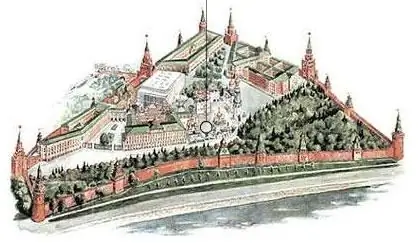- Author Harold Hamphrey [email protected].
- Public 2023-12-17 10:06.
- Last modified 2025-01-24 11:10.
Kazan Cathedral on Red Square is a small but very memorable building. Learn more about its construction later in the article.
Temple History
Kazan Cathedral in Moscow has been rebuilt many times since its construction. In 1625, a wooden church was built on this site with the money of Prince Dmitry Pozharsky. It was named after the miraculous Kazan Icon of the Mother of God.
The fire of 1635 destroyed the church, and soon it was replaced by a stone cathedral erected by Tsar Mikhail Fedorovich Romanov. The following year, the temple was consecrated by Patriarch Joseph. Gradually, it becomes one of the most important places of worship. In 1812, during the war with Napoleon, Kutuzov received a blessing here. This event made the cathedral the first monument of the Patriotic War.
Kazan Cathedral on Red Square noticeably changes its appearance in the period from the 17th to the 19th centuries. As a result of reconstruction, the temple becomes little distinguishable from other Moscow cathedrals and churches. In 1925, the reconstruction of the religious building began. The temple returns to its original form. However, the renovated cathedral did not last long. In 1936, the Soviet government decided to demolish it. temple is notcorresponded to the purpose of the main square of the state - holding ceremonial events.
Instead of a cathedral, the square housed a pavilion dedicated to the Internationale and a public toilet. In 1990, the toilet was closed, and the construction of the temple began again. The new Kazan Cathedral (see photo below) repeated the features of the previous one. It was possible to recreate the previous view with the help of drawings and measurements made by Pyotr Baranovsky before the demolition of the temple.

Icon of Our Lady of Kazan
The acquisition of the icon dates back to 1579, when a strong fire turned part of Kazan and the Kazan Kremlin into ruins. Sagittarius Daniil Onuchin, whose house was badly damaged by fire, immediately began to rebuild a new house, and under a layer of ashes discovered the icon of the Mother of God.
According to legend, the Mother of God appeared three times in a dream to the ten-year-old daughter of an archer. The Mother of God asked the girl to find the hidden icon. At first, no one believed the child, but going to the indicated place, Daniel found a sacred image wrapped in cloth. Soon, rumors about miraculous healings, thanks to the icon, spread throughout the city.
The Kazan icon has long served as a symbol of protection and patronage for Russian soldiers. Before the Battle of Poltava, Tsar Peter I prayed to her for victory, during the years of the Russian-French War - Mikhail Kutuzov. During the war with the Poles, Russian troops carried miraculous lists of the icon with them, and after the successful end of the battle, it was promised to build a temple in honor of the Kazan Mother of God on Red Square.

Kazan Cathedral: photo and description of architecture
Initially, the stone temple had the features of typical architectural structures of the late XIV century. A small pillarless cathedral repeated the outlines of the Rubtsovskaya Church of the Intercession of the Virgin and the cathedral in the Donskoy Monastery.
Unlike similar churches, the Kazan Cathedral on Red Square was devoid of symmetry. The composition was broken by the fact that the chapel was only on one side. Later, another chapel was added to the cathedral in honor of Saints Guriy and Barsanuphius. A hipped bell tower appears - one of the first of its kind in Moscow. Later, it is replaced first by a two- and then a three-tiered bell tower.
At the top of the temple there were kokoshniks in a checkerboard pattern. Small and large were placed in turn, giving the temple a toy and solemn look. In the second half of the 19th century, the architect Nikolai Kozlovsky began to redesign the facade. The temple acquired a classical look, having lost its distinctive features. Many parishioners were outraged by such a transformation of the shrine, and Metropolitan Leonty even compared it to a typical rural church.
Thanks to the architect Baranovsky, who saved and restored more than one Russian church, we can observe the Cathedral of the Kazan Icon of the Mother of God almost in its original form. This is a square in plan single-domed structure, made in red and white colors. The top of the temple is decorated with kokoshniks. The main dome of the temple is covered with gold. From three there are galleries leading to the bell tower. Small and large kokoshniks alternating with each other create the effect of volume and patterning of the composition.

Location, opening hours of the temple
Kazan Cathedral is located on Red Square, opposite the State Historical Museum, on Nikolskaya Street, 3. There are three metro stations next to it: Revolution Square, Okhotny Ryad, Teatralnaya. The entrance to the temple is located from the Red Square.
The cathedral is open daily from 8 am to 8 pm. Church services are held on holidays and Sundays from 7 am to 10 am.

Conclusion
Kazan Cathedral on Red Square was first built in 1625. Since that time, it has been destroyed several times, and has experienced numerous reconstructions, each time changing its appearance. Newly erected in 1990, the cathedral is now a monument of Russian history and architecture, testifying to important historical events in the country.






